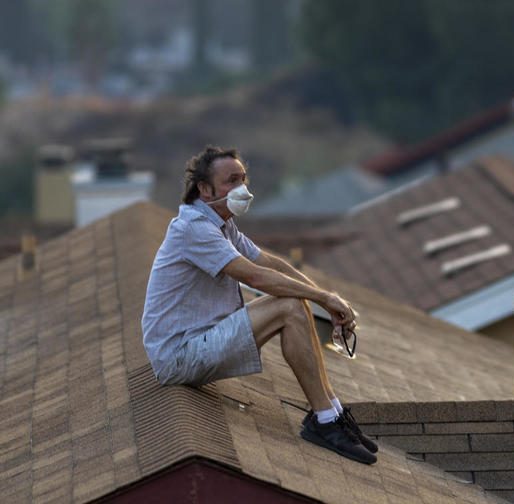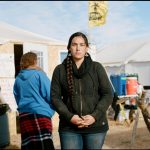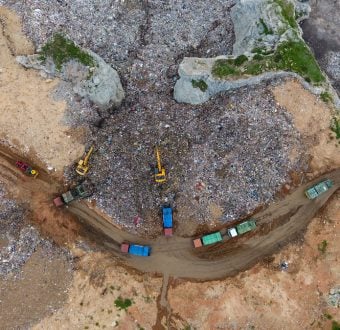Updated September 10, 2020
As wildfires rage across the state of California, my thoughts are with the thousands of Californians who have been evacuated and whose homes and businesses are in the fire’s path.
In 2018, my family and neighbors were evacuated from the Carr Fire, which left many of us without homes. I remember how overwhelming it was to make safe evacuation plans then, but it’s hard to imagine navigating that already difficult task with the additional thread of the COVID-19 pandemic.
This year, we’re experiencing what has become the largest wildfire in California history and three of the four largest fires in the state’s history burning simultaneously. As I’m writing this now, 7,694 fires have burned through a record-breaking 3 million acres – that’s the most acreage burned in a single wildfire season in California. So far, evacuations have impacted more than 100,000 Californians. These wildfires and evacuations are playing out during a global pandemic, record-breaking heat waves, and power blackouts.
With so many simultaneous crises, knowing how to respond and stay safe feels overwhelming to say the least. As we respond, it’s also important to consider the ways these issues intersect, the root issues making the situation worse, and which communities will be most impacted. This blog post is meant to explore those connections and also provide you with information and resources to help you stay safe and take care of those around you.
Part 1: Intersecting Crises
Climate Chaos
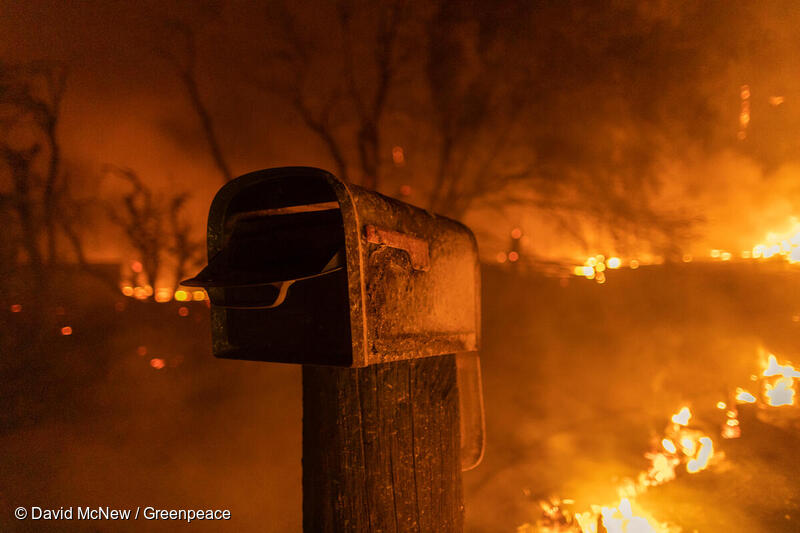
California Pine Canyon Wildfire, ⓒ David McNew, 2020
First off, as Governor Newsom himself has called out, we have to acknowledge the ways that the climate crisis is fueling extreme weather events, including an exceptionally dry winter and record-breaking heat waves which leave more dried up wildland vegetation to kindle the fires.
What we’re seeing in California now is the unfortunate reality that we don’t have the luxury to tackle one crisis at a time. While climate change is fueling wildfires, the wildfires are in turn worsening air quality and increasing the public health risks for communities at greatest risk of COVID-19. Meanwhile, the pandemic is complicating the state’s ability to respond to the fires and safely evacuate Californians in the path of these fires.
Plus, extreme weather events often come with their own unanticipated side effects, as we saw when as many as 2 million Californians lost power during a record-breaking heatwave this month. These blackouts are doubly dangerous during a heatwave and a pandemic, when access to electricity can be a life-or-death situation for the sick, elderly, and those who rely on medical equipment.
Public Health Emergency
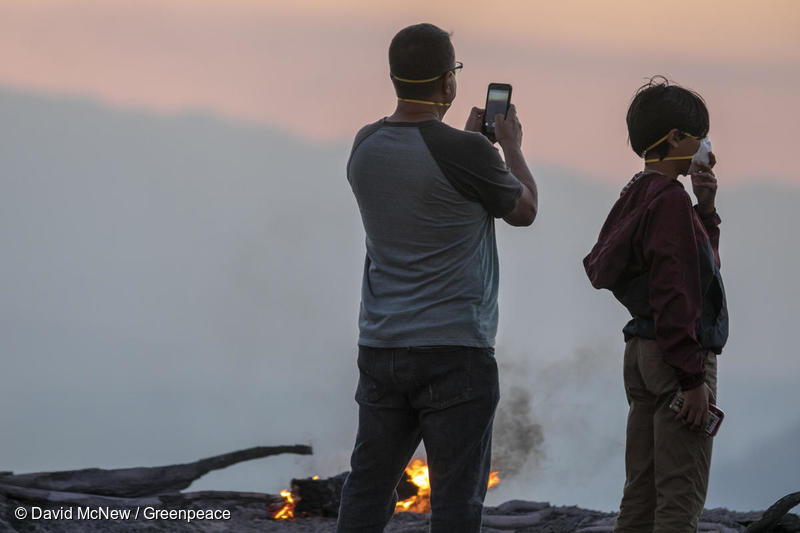
California Tick Fire, ⓒ David McNew, 2019
The Bay Area’s daily air quality has repeatedly reached the “worst in the world” status as a result of fires and smoke blowing across the region.
Wildfire smoke contains large amounts of soot and other fine particles that can aggravate asthma and other respiratory problems, and has been shown to increase the risk of lung infections like pneumonia. Exposure to wildfire smoke is associated with: respiratory illnesses; adverse birth outcomes; cardiovascular disease; and premature mortality. During the COVID-19 pandemic, which poses greater risks to communities with air pollution, unhealthy air is a serious public health emergency.
Deadly air pollutants are exacerbated by dangerous smoke from these fires that threaten children, elderly populations, pregnant women, socioeconomically disadvantaged populations, outdoor workers, people experiencing homelessness, and those with compromised immune systems and preexisting respiratory and cardiovascular conditions.
As we deal with a public health crisis centered around a respiratory disease, the last thing we need is more pollution that worsens respiratory problems and deepens already disproportionately higher risks of COVID-19 for Black, Brown, Indigenous, and low-income communities.
Municipalities need to focus on providing masks, safe and socially distanced smoke shelters, and other public health responses to enable communitie
What’s driving the climate crisis and further endangering public health? Fossil Fuels.
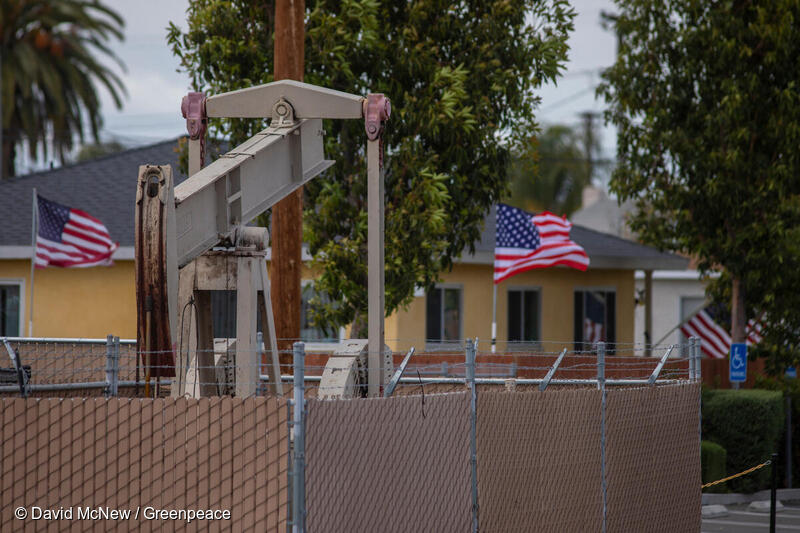
Wilmington, Los Angeles, ⓒ David McNew, 2020
While we must address the immediate needs of evacuating people safely and protecting sensitive groups from air pollution, we cannot afford to ignore a root-level problem that is fueling climate chaos, and thus these extreme weather events, as well as further jeopardizing public health during a pandemic and on top of hazardous wildfire smoke.
Fossil fuel extraction is simultaneously driving our climate crisis – which is making California’s wildfires bigger and faster – and worsening public health risks for communities living near oil and gas drilling.
For decades, these communities have faced their own public health crisis – suffering higher rates of asthma and other respiratory diseases, preterm births and high-risk pregnancies, and cancer – which now put them at greater risk to COVID-19. And as COVID-19 has laid bare, this public health crisis exposes deeper societal and environmental racism. Of the 1.8 million Californians living near drilling in heavily polluted areas, 92 percent are communities of color.
While it isn’t news that the fossil industry is the main driver of the climate crisis, California remains one of the top oil-producing states in the country. What’s truly cynical is that while Governor Newsom has been quick to connect the dots between these wildfires and climate change, he’s failed to mention the 1,500 new oil and gas permits he’s issued this year, and the 48 new fracking permits issued since the pandemic hit California in March. In fact, in the first six months of 2020 alone, Governor Newsom has granted 190% more permits to drill new oil and gas wells compared to the same period last year.
As California experiences record-breaking heatwaves and devastating wildfires, it’s not enough for our leaders just to believe in climate science: we need them to act on it. That means making changes now to move away from fossil fuels that further endanger public health and hasten climate disruption, and instead invest in a new, just, safe, and equitable energy system that includes a just transition for communities most impacted by the fossil fuel industry.
Want to learn more about other root issues behind the climate crisis and California’s wildfires, including how the logging industry is making communities less safe? Check out this blog post, What Should We Know About Wildfires in California.
We Can’t Afford to Address One Crisis at a Time
The main takeaway from examining these multiple intersecting crises is that the climate crisis, racial injustice, and public health are interlinking issues and we cannot afford to address one crisis at a time.
For example, when PG&E and other utilities cut off power to millions of Californians, Newsom’s response was to use back-up diesel generators to avoid future blackouts, which required him to roll back air pollution rules during a pandemic and wildfires, thus deepening air pollution that disproportionately impacts Black, Brown, Indigenous, and low-income communities.
For too long, California’s elected leaders have answered to destructive industries that put profits over people. If we continue to allow the fossil fuel and logging industries to dictate the way land is used, shape our policies, and mold our emergency response, they’ll continue to fuel the climate crisis, air pollution, and destructive wildfires.
As Governor Newsom responds to the current crisis and prepares for tomorrow’s challenges, he must chart a path to a more just, resilient, and sustainable energy future for California, rather than continuing to invest in the problems that are causing these crises. That starts with standing up to the destructive industries that are fueling these wildfires.
Part 2: How to Respond
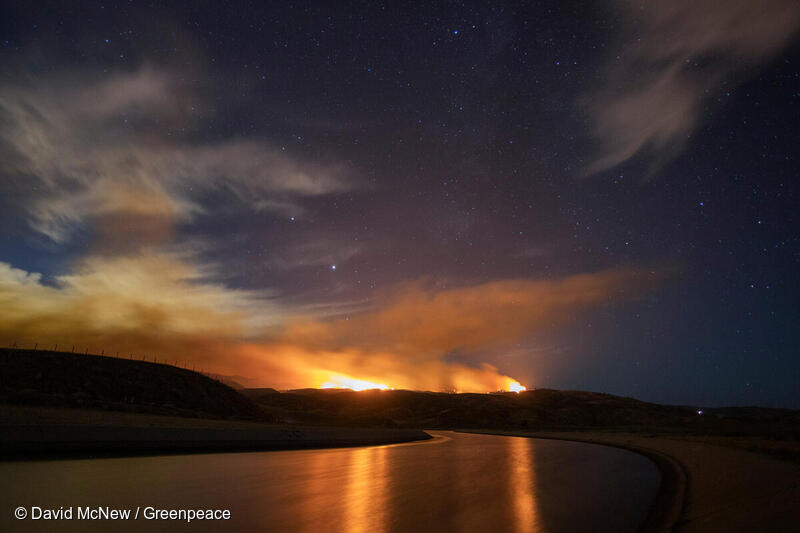
California Lake Fire, ⓒ David McNew, 2020
While getting real about the root issues is urgently important, millions of Californians are being forced to deal with the immediate task of safety and survival. We’ve compiled this guide to help you respond to these intersecting crises in order to stay safe and mitigate their impacts on you, your loved ones, and your community. You can download it here or share the tips below.
Do you have resources for responding to these crises or know of wildfire relief efforts in your community? Please share below in the comments!
Quick Tips
Here’s how you can stay safe:
😷 Monitor local air quality: https://bit.ly/3iXA70F
😷 If you smell smoke, stay indoors & close the windows.
😷 Get an HVAC or HEPA filter, or make your own: https://bit.ly/3l4Ph6m
😷 Wear a mask outdoors (see our n95 guidance here: https://bit.ly/2YDkmnN)
Here’s how you can prepare if you’re in a wildfire-prone area:
🧯Prepare your Emergency Supply Kit: https://bit.ly/2Yj6z5M
🧯Sign up for @Cal_Fire active wildfire updates: https://bit.ly/2FGlMaD
🧯Have a Wildfire Action Plan (& plan w COVID in mind): https://bit.ly/2EkOL2S
Here’s what you can do to prepare for blackouts:
💡 Sign up for alerts from your local utility: https://bit.ly/31ttcq2
💡 Get a back-up charger for your phone
💡 Don’t forget that emergency supply kit! 🧰
💡 Check out these tips for staying cool & conserving power 😰 https://lat.ms/3iWXJCK
